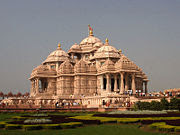 The India Gate commemorates Indian soldiers who died in World War I
The India Gate commemorates Indian soldiers who died in World War IDelhi is India's main point of arrival for overseas visitors, and the major transport hub for destinations in the states of rajasthan, the Punjab, Himachal Pradesh and Ladakh as well as central north India. Delhi city, the showacse of India, has been the centre of political activity from time immemorial. The ancient fortness, majestic buildings and historic ruins find their modern counterparts in the tall skyscrapers, diplomatic enclaves and well-planned townships of New Delhi. The people here, their lifestyles, traditions and even the climate are a rich and varied mixture of all that is india.
 Lotus Temple in South Delhi
Lotus Temple in South DelhiDelhi is one of the oldest continually inhabited cities in the world. Having been the capital of several empires in ancient India, Delhi was a major city in the old trade routes from northwest India to the Gangetic Plains. Many ancient monuments, archaeological sites and remains of national importance have been erected in its history.[7] The Mughals built a section of the city (now known as Old City or Old Delhi) that served as the capital of Mughal Empire for a long period. During the British Raj, New Delhi was built as an administrative quarter of the city. New Delhi was declared the capital of India after India gained independence from British rule in 1947. As the seat of the Government of India, New Delhi houses important offices of the federal government, including the Parliament of India, making Delhi a powerhouse of Indian politics.
 The Akshardham Temple
The Akshardham TemplePublic transport in Delhi is provided by buses, auto rickshaws, a rapid transit system, taxis and suburban railways.
